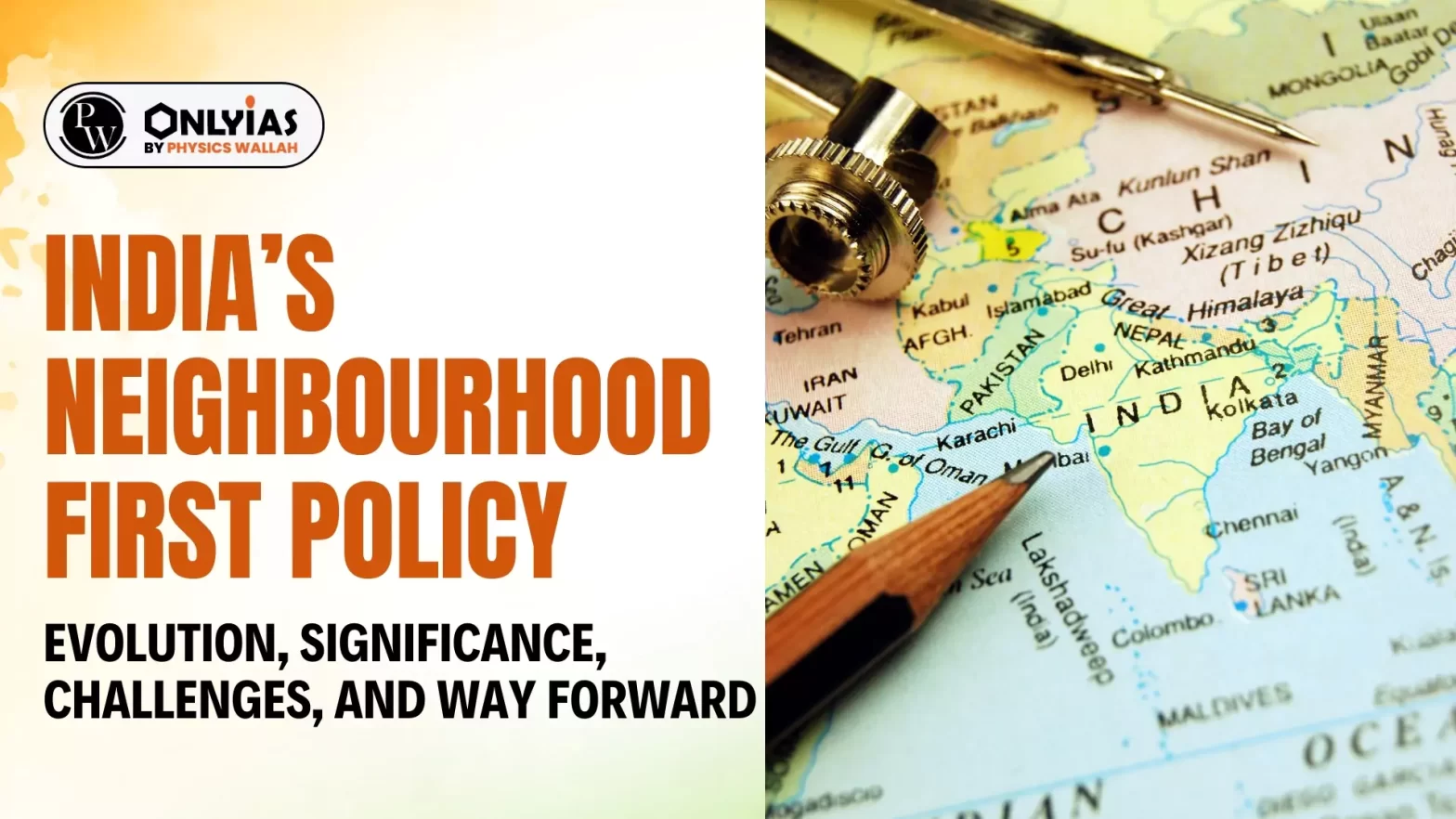Context
The recent visit of the Bhutanese Prime Minister to India, followed by the announcements of the visit of the Indian Prime Minister to Bhutan, exemplifies India’s commitment to neighbourhood first policy.
About India Bhutan Relationship
- Historical Perspective: Diplomatic relations between Bhutan and India were established in January 1968, with the establishment of a special office of India in Thimphu.
- Basic Framework: Treaty of Friendship and Cooperation signed in 1949 between the two countries, which was renewed in 2007 serves as the basic framework.
- Spiritual Kinship: Bhutan considers India as “gyagar,” the sacred land where Buddhism originated. Buddhism has kept the ties between the two countries resilient.
|
About Neighbourhood First Policy
- Neighbourhood First Policy (NFP) was conceived in 2008 wherein the principles of engagement under NFP were 5S (Samman, Samvad, Shanti, Samriddhi and Sanskriti).
- It aims to foster stronger ties, enhance regional cooperation, and address mutual concerns with immediate neighbouring countries.
- The Policy is driven by India’s consultative, nonreciprocal and development-oriented approach.
Evolution of Neighbourhood first Policy
- India’s approach has evolved from anti-colonial solidarity to fostering regional hegemony, and then to becoming a responsible leader aiming for mutual trust and cooperation.
- 2014 onwards: Revamping NFP to strengthen ties through economic cooperation, development assistance, and addressing shared challenges.
- The NFP received a boost from all neighbours except Pakistan. Greater emphasis was also laid on regional and sub-regional initiatives, through SAARC and BIMSTEC.
Significance of Neighbourhood First Policy
-
Strategic and Geopolitical Interests:
- Leadership in the Region: NFP bolsters India’s central role in the strategically competitive Indian Ocean Region (IOR) and positions it as a regional leader.
- Balancing Regional Powers: NFP focuses on India’s strategic maneuvering to counterbalance expanding Chinese influence and solidify its position as a net security provider in the IOR.
- Multilateral Collaboration: The policy emphasizes on the importance of neighboring alliances in reinforcing India’s stance in global platforms and fostering regional cohesion.
-
National Security Interests:
- Safeguarding Sovereignty: The NFP underlines the need for cooperative neighbors to deter cross-border insurgencies and uphold India’s territorial sovereignty.
- Securing Maritime Borders: NFP promotes collaborative maritime security initiatives with proximate countries like Sri Lanka, Maldives etc. to ensure safe and secure Indian waters.
-
Economic and Developmental Interests:
- Securing Energy Resources: The policy explores the hydroelectric potential of Himalayan neighbors and the criticality of maritime routes for energy imports.
- North-Eastern Development through Regional Integration: It discusses how enhanced connectivity and trade with neighbors can spur development in India’s North-Eastern region.
-
Soft Power Diplomacy:
- Leveraging Historical Ties for Regional Influence: The Policy considers India’s use of its rich cultural heritage to strengthen diplomatic relations and enhance regional influence through soft power.
- For instance, the prevalence of Buddhism in India and Southeast Asia acts as a tool to strengthen people-to-people ties and diplomatic relations.
Challenges to Neighbourhood First Policy
-
Comprehensive Policy Framework:
- Policy Ambiguity: There’s a perception that India lacks a clearly defined neighbourhood strategy, leading to a reactive rather than a proactive approach in shaping relationships with neighbouring countries.
- Regional Cooperation Hurdles: Strained relations among regional nations affect the collective implementation of policies, illustrated by the partial success in signing agreements at SAARC summits due to objections from specific countries like Pakistan.
-
Security Concerns:
- Cross-Border Terrorism: Permeable borders and external support for terrorism in countries like Pakistan contribute to security threats in India.
- Drug Trafficking and Piracy: Proximity to drug-producing regions and piracy risks off the Somali coast exacerbate India’s security and trafficking issues.
- Illegal Migration: Relations with Bangladesh have been strained due to domestic political rhetoric in India concerning illegal migration.
-
Rising Influence of China:
- China’s Economic Expansion: China’s Belt and Road Initiative (OBOR) has significantly increased its trade with South Asian countries, challenging India’s influence.
- Leveraging China Against India: Neighboring countries occasionally use China as leverage against India, affecting bilateral relationships.
-
Building Confidence with Neighbours:
- Perceived Inequality: Neighbors sometimes feel India does not treat them as equals, impacting regional trust. Historical military involvements are viewed with suspicion and contribute to apprehensions.
-
Economic Challenges in the Neighbourhood:
- Regional Economic Instabilities: Economic crises in countries like Sri Lanka impact India’s exports and reflect broader regional economic vulnerabilities.
- LOC Project Delays: Significant delays in implementing Line of Credit projects to neighboring countries cause frustration and diminish India’s influence and trust in the region.
-
Connectivity and Infrastructure Deficits:
- Underdeveloped Border Areas: Lack of infrastructure at borders hampers trade and unrestrained movement, with many border districts needing development and connectivity projects delayed.
-
Domestic Politics Influencing Foreign Policy:
- Political and Ethnic Sensitivities: Domestic politics and ethnic considerations sometimes dictate India’s foreign policy towards neighbors, affecting agreements like the Teesta Waters and engagement with ethnic groups in Sri Lanka and Nepal.
-
Environmental Challenges:
-
- Climate Change and Disasters: The region’s vulnerability to natural disasters and climate change poses additional challenges, potentially leading to climate migration and disrupting development efforts.
Way Forward
- Revitalising and Utilising Regional Forums: There is a need to actively engage and leverage platforms like SAARC, BIMSTEC, and IORA for continuous diplomatic engagement, dispute resolution, and promotion of regional unity.
- Strategic Relations with China and Pakistan
- Negotiations with China: It is needed to prioritise defining the LAC clearly while firmly resisting any violations, adhering to the Border Defence Cooperation Agreement.
- Counter-Terrorism Collaboration: There is a need to work with regional and global entities to establish a counter-terrorism platform and consider economic ties with Pakistan, contingent upon its support for broader people-to-people exchanges.
- Strengthen Internal Security: It is needed to bolster India’s internal security mechanisms to effectively counter terrorist activities and ensure a proactive response from neighboring nations.
- International Collaborations: Reorientation of India’s foreign policy to build strategic alliances with major global powers like the US, Russia, and the EU, and actively engage in international forums such as the UN, BRICS, and G20 to address regional challenges.
- Tailored Diplomatic Efforts: It is needed to fine-tune India’s diplomatic initiatives to address the specific concerns and aspirations of smaller neighbouring countries through enhanced domestic coordination.
- Infrastructure Investments: Commit to significant infrastructure enhancements, including transport networks and digital customs, viewing economic connectivity as beneficial rather than a security risk.
- Investment in Tourism: India needs to promote investments in the tourism sector, including medical tourism, to strengthen people-to-people ties, enhance soft power, and support economic integration.
- Environmental Collaboration: India should foster joint efforts in water management and environmental protection through data exchange and scientific research, addressing shared ecological challenges.
Conclusion
India’s Neighbourhood First Policy (NFP) dynamically adapts to the region’s evolving landscape, highlighting India’s commitment to shaping a prosperous South Asian future. This strategic approach is vital for fostering a stable and affluent neighbourhood that aligns with India’s national and foreign policy goals.
Also Read: Changing Dynamics Of India’s Foreign Policy
To get PDF version, Please click on "Print PDF" button.

